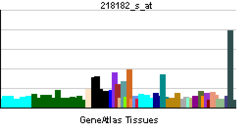- CLDN1
-
Claudin 1 Identifiers Symbols CLDN1; CLD1; ILVASC; SEMP1 External IDs OMIM: 603718 MGI: 1276109 HomoloGene: 9620 GeneCards: CLDN1 Gene Gene Ontology Molecular function • structural molecule activity
• identical protein bindingCellular component • plasma membrane
• integral to plasma membrane
• tight junction
• integral to membrane
• lateral plasma membrane
• cell junctionBiological process • cell adhesion
• calcium-independent cell-cell adhesion
• interspecies interaction between organismsSources: Amigo / QuickGO RNA expression pattern 
More reference expression data Orthologs Species Human Mouse Entrez 9076 12737 Ensembl ENSG00000163347 ENSMUSG00000022512 UniProt O95832 Q4FJV3 RefSeq (mRNA) NM_021101.4 NM_016674.4 RefSeq (protein) NP_066924.1 NP_057883.1 Location (UCSC) Chr 3:
190.02 – 190.04 MbChr 16:
26.36 – 26.37 MbPubMed search [1] [2] Claudin-1 is a protein that in humans is encoded by the CLDN1 gene.[1][2] It belongs to the group of claudins.
Tight junctions represent one mode of cell-to-cell adhesion in epithelial or endothelial cell sheets, forming continuous seals around cells and serving as a physical barrier to prevent solutes and water from passing freely through the paracellular space. These junctions are composed of sets of continuous networking strands in the outwardly facing cytoplasmic leaflet, with complementary grooves in the inwardly facing extracytoplasmic leaflet. The protein encoded by this gene, a member of the claudin family, is an integral membrane protein and a component of tight junction strands. Loss of function mutations result in neonatal ichthyosis-sclerosing cholangitis syndrome.[3]
Interactions
CLDN1 has been shown to interact with CLDN5[4] and CLDN3.[4]
References
- ^ Halford S, Spencer P, Greenwood J, Winton H, Hunt DM, Adamson P (Jun 2000). "Assignment of claudin-1 (CLDN1) to human chromosome 3q28→q29 with somatic cell hybrids". Cytogenet Cell Genet 88 (3–4): 217. doi:10.1159/000015553. PMID 10828592.
- ^ Morita K, Furuse M, Fujimoto K, Tsukita S (Mar 1999). "Claudin multigene family encoding four-transmembrane domain protein components of tight junction strands". Proc Natl Acad Sci U S A 96 (2): 511–6. doi:10.1073/pnas.96.2.511. PMC 15167. PMID 9892664. http://www.pubmedcentral.nih.gov/articlerender.fcgi?tool=pmcentrez&artid=15167.
- ^ "Entrez Gene: CLDN1 claudin 1". http://www.ncbi.nlm.nih.gov/sites/entrez?Db=gene&Cmd=ShowDetailView&TermToSearch=9076.
- ^ a b Coyne, Carolyn B; Gambling Todd M, Boucher Richard C, Carson Johnny L, Johnson Larry G (Nov. 2003). "Role of claudin interactions in airway tight junctional permeability". Am. J. Physiol. Lung Cell Mol. Physiol. (United States) 285 (5): L1166–78. doi:10.1152/ajplung.00182.2003. ISSN 1040-0605. PMID 12909588.
Further reading
- Kniesel U, Wolburg H (2000). "Tight junctions of the blood-brain barrier". Cell. Mol. Neurobiol. 20 (1): 57–76. doi:10.1023/A:1006995910836. PMID 10690502.
- Heiskala M, Peterson PA, Yang Y (2001). "The roles of claudin superfamily proteins in paracellular transport". Traffic 2 (2): 93–8. doi:10.1034/j.1600-0854.2001.020203.x. PMID 11247307.
- Tsukita S, Furuse M, Itoh M (2001). "Multifunctional strands in tight junctions". Nat. Rev. Mol. Cell Biol. 2 (4): 285–93. doi:10.1038/35067088. PMID 11283726.
- Tsukita S, Furuse M (2003). "Claudin-based barrier in simple and stratified cellular sheets". Curr. Opin. Cell Biol. 14 (5): 531–6. doi:10.1016/S0955-0674(02)00362-9. PMID 12231346.
- González-Mariscal L, Betanzos A, Nava P, Jaramillo BE (2003). "Tight junction proteins". Prog. Biophys. Mol. Biol. 81 (1): 1–44. doi:10.1016/S0079-6107(02)00037-8. PMID 12475568.
- Swisshelm K, Macek R, Kubbies M (2005). "Role of claudins in tumorigenesis". Adv. Drug Deliv. Rev. 57 (6): 919–28. doi:10.1016/j.addr.2005.01.006. PMID 15820559.
- King JE, Eugenin EA, Buckner CM, Berman JW (2006). "HIV tat and neurotoxicity". Microbes Infect. 8 (5): 1347–57. doi:10.1016/j.micinf.2005.11.014. PMID 16697675.
- Ye J (2007). "Reliance of host cholesterol metabolic pathways for the life cycle of hepatitis C virus". PLoS Pathog. 3 (8): e108. doi:10.1371/journal.ppat.0030108. PMC 1959368. PMID 17784784. http://www.pubmedcentral.nih.gov/articlerender.fcgi?tool=pmcentrez&artid=1959368.
- Furuse M, Fujita K, Hiiragi T et al. (1998). "Claudin-1 and -2: novel integral membrane proteins localizing at tight junctions with no sequence similarity to occludin". J. Cell Biol. 141 (7): 1539–50. doi:10.1083/jcb.141.7.1539. PMC 2132999. PMID 9647647. http://www.pubmedcentral.nih.gov/articlerender.fcgi?tool=pmcentrez&artid=2132999.
- Swisshelm K, Machl A, Planitzer S et al. (1999). "SEMP1, a senescence-associated cDNA isolated from human mammary epithelial cells, is a member of an epithelial membrane protein superfamily". Gene 226 (2): 285–95. doi:10.1016/S0378-1119(98)00553-8. PMID 9931503.
- Furuse M, Sasaki H, Tsukita S (1999). "Manner of interaction of heterogeneous claudin species within and between tight junction strands". J. Cell Biol. 147 (4): 891–903. doi:10.1083/jcb.147.4.891. PMC 2156154. PMID 10562289. http://www.pubmedcentral.nih.gov/articlerender.fcgi?tool=pmcentrez&artid=2156154.
- Itoh M, Furuse M, Morita K et al. (2000). "Direct binding of three tight junction-associated MAGUKs, ZO-1, ZO-2, and ZO-3, with the COOH termini of claudins". J. Cell Biol. 147 (6): 1351–63. doi:10.1083/jcb.147.6.1351. PMC 2168087. PMID 10601346. http://www.pubmedcentral.nih.gov/articlerender.fcgi?tool=pmcentrez&artid=2168087.
- Krämer F, White K, Kubbies M et al. (2000). "Genomic organization of claudin-1 and its assessment in hereditary and sporadic breast cancer". Hum. Genet. 107 (3): 249–56. doi:10.1007/s004390000375. PMID 11071387.
- Miyamori H, Takino T, Kobayashi Y et al. (2001). "Claudin promotes activation of pro-matrix metalloproteinase-2 mediated by membrane-type matrix metalloproteinases". J. Biol. Chem. 276 (30): 28204–11. doi:10.1074/jbc.M103083200. PMID 11382769.
- Hamazaki Y, Itoh M, Sasaki H et al. (2002). "Multi-PDZ domain protein 1 (MUPP1) is concentrated at tight junctions through its possible interaction with claudin-1 and junctional adhesion molecule". J. Biol. Chem. 277 (1): 455–61. doi:10.1074/jbc.M109005200. PMID 11689568.
Categories:- Human proteins
- Chromosome 3 gene stubs
Wikimedia Foundation. 2010.
